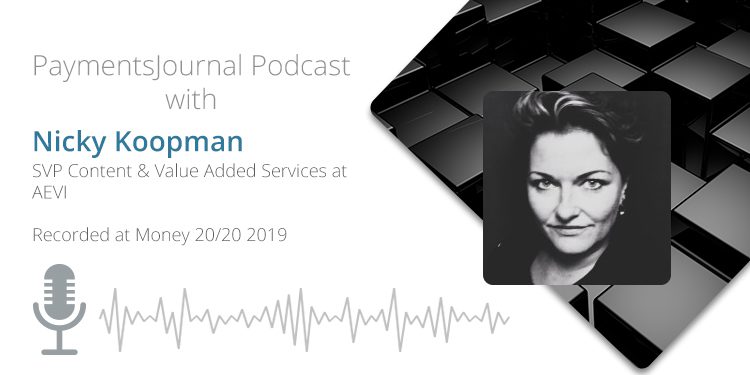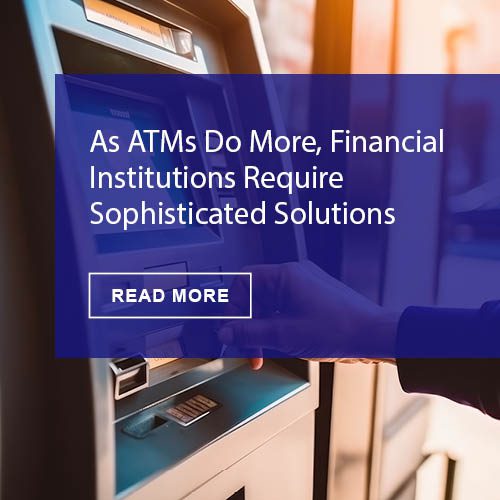This is a transcription of an interview between PaymentsJournal and Nicky Koopman, Senior Vice President of Content & Value Added Services at AEVI, at the Money 20/20 event:
PaymentsJournal
Welcome to the PaymentsJournal podcast. I’m your host Ryan Mac, and today’s episode is a conversation that I had with Nicky Koopman, the SVP of Content and Value Added Services at AEVI, at Money20/20. Now during this conversation, we talked about the traditional ISO model being outdated, and how ISOs can become a merchant solution provider, as well as how AV was innovating in this space. So without any further delay, let’s start the show.
So, Nicky, thank you so much for joining me on today’s episode. So, looking at the acquiring market in 2019, we really see two trends. The first is the rise of ISVs offering payment services and the second is the announcement of the so called “industry mega mergers.” Therefore, the first question that I have is, you know, is the traditional acquirer/bank ISO model outdated?
Nicky Koopman
I understand where you come from Ryan. I mean more and more payment intermediaries, such as Amazon or Square, Stripe, or the big tax like Apple Pay or Google Play, are entering and they’re all fighting over merchant dominance, especially now with the digital and physical world truly converging. And looking at providing services to global big players, consolidation makes a lot of sense as acquirers can play the economies of scale game, consolidating a bigger payments volume on to their legacy pipes, while at the same time expanding their global footprint product offering. Nevertheless, this is a numbers game that does not change the position of the acquirers. But to answer your question, from our perspective, both acquirers and ISOs have the same, if not more, relevancy for 2020. The reason is simple. We are living in a world of abundance, with many absolutions being available, that’s traditional App Store. And there’s so much choice that it is hard to differentiate between the good ones, the bad ones, and the actual relevant ones for you. And there is a need for professional solution curation, especially in the SMB space. And this is where both acquirers, as the enablers of such solutions, and the ISOs, as the consulting partners, especially for those, of which there are still many, non-tech savvy merchants. Nevertheless, both acquirers and ISOs have to realize that the merchant mindset has changed and merchants are looking for business solutions rather than merchant accounts, and some software in parallel. And this is why traditional players are at the crossroads. Either they step forward, offering visions, solution sets, to merchant ecosystems to the merchants, or they step back and concentrate on offering streamline solutions to upcoming business solution providers and become a payment for facilitator. The first results into value creation discussion with the merchant directly, while the latter often offers a pricing discussion.
PaymentsJournal
Excellent. No, I mean obviously all of that sounds, you know, completely logical, but listening to that I really now have to ask how can an acquirer ISO become a merchant solution provider? And how, you know, can such a solution look like?
Nicky Koopman
So, so very good question. Embracing merchant solutions should not be seen as a defensive strategy to stop losing merchants and the SMB segment, it should actually be seen as an active step to provide more and more means, more services to the merchants, more openness towards collaborating with interesting solution providers, but also newer, engaging discussions with merchants about their needs and services that they can provide. So, from our perspective and acquirer needs to first answer the question for itself, whether it really wants to change or differentiate and become a merchant solution provider, as it requires really a mentality shift. And the shift really shifts in being a payment processor to becoming a merchant solution provider. And with this, this really requires a different approach as the traditional model is simply dealing with cost, while the latter really deals with value and “how can we help you grow your business?” And the first step, if you want to play in this space, is to look at the different industries where the SMB space is, and where the acquirer really wants to serve and in what segments of this industry it wants to serve directly. And to give you an example of what that means, is when you look at really the micro merchants, they are very much focused on payment acceptance. They do require a simple black box that allows them to type in an amount and dip the card. And this is the market established by the impulse providers right, such as Square, and requirements are so simple that the solution does not need a long explanation. Also as customer acquisition costs in these market segments are quite high with regards to the return, this is predominantly a self-help/shelf board, no frills market. Another example is then the small merchants, where they require solution sets that already cater for their industry best if they come in a form of a “Lego block approach”, as I call it, where they can get a basic industry bundle and then enhance it with additional models to whatever they will need for their specific business.
And once the acquirer has decided on which industry and merchant segments they would like to play, the next step is then really to find solution sets that fit that exact need of that industry segment. Whereas, a solution set consists of software and hardware components, right, it’s a mix. And to give you an example there, for a local car garage having an online/offline appointment scheduling app will already dramatically help them managing their workloads. Combining that with, for example, a flexible staff scheduling tool, the owner of the garage can significantly boost top line revenue and reduce cost. And here we have not even touched the payments aspects of all of this. So this is really where the acquirer can become the trustworthy advisor, supporting merchants who want to become more digital and agile and taking them by the hand. And this is just the beginning. I mean, if you look at a merchant ecosystem, it can offer acquirers and banks a completely new way to interact with their merchants. And not only can a solution, such as Smart POS, act as a direct communication channel between merchants and the acquirer/bank, it can also proactively help the merchant grow. Either through offering them additional services or apps, like online sales capabilities at the right time, which are fast access to, for example, loans to build out the business, or investing in opening new locations. And for me, all of these finds make this investment so worthwhile. And I guess the good news for acquirers is that their partners, like ourselves, will want to empower them to really become next generation ready.
PaymentsJournal
Excellent. Now we’re certainly covering a lot of things here. So let’s now really kind of nail into it. Where does AEVI fit into all of this that we’re discussing today?
Nicky Koopman
It indeed is a lot and this is not easy, right? If this was easy everybody would be doing it – and that’s where we come in. AEVI provides its clients with all functionality and support to move and manage the classic payments proposition into really a new world of value added apps, payments and smart devices. And we do not only provide an open and agnostic platform to deliver the new merchant experience across the widest range of AEVI enabled smart devices, but we also offer access to a wide range of professional app solution providers. And on top of that, we also help truly with the go-to-market strategy so how to offer these type of solutions to these merchants, which would also include sales enablement, smooth merchant onboarding, merchant support, because as you move into this value add world the merchant is your number one priority, right? And the needs to be a smooth experience for them. And this means the bank can really offer the ultimate merchant experience and make the change from processor to proactive solution provider. So that’s what we do.
PaymentsJournal
So now, before I wrap things up here, we’re here at Money 20/20 event. And obviously, there’s a lot of discussion just around payments and the payments trends and things like that. So beyond what it is that we’re talking about today, what are some of the things that you’re most excited about seeing at this event?
Nicky Koopman
I am very happy to see that more and more companies look into the SMB space and also understand that there’s no “one fits all” solution, and what personally, so outside of the event, but what I’m extremely excited for is that with these type of solutions, we effectively can help these small businesses, independent shop owners, to really start competing with the big boys. And I think that’s beautiful from a merchant perspective, from a consumer perspective, but also if you look at it from an industry perspective, where this is something we should do altogether, right, and we should do what we do best and if together we can make it work, then the merchant will benefit from it. But equally, so will we if we walk into this great coffee shop, that was excellent coffee, but now it also offers loyalty and knows exactly what you like, how you like it, and the 11th one is for free. And that is what makes me extremely excited.
PaymentsJournal
Excellent. Well, thank you, Nicky, for taking the time today for joining me on today’s episode, and I hope to have you back on the podcast real soon.
Nicky Koopman 10:36
Thank you so much, Ryan. It was a pleasure.











